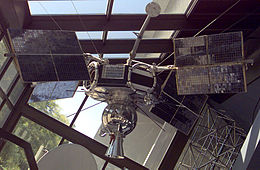Explorer 33
 | |
| Mission type | Magnetospheric research |
|---|---|
| Operator | NASA |
| COSPAR ID | 1966-058A |
| SATCAT no. | 2258 |
| Mission duration | 1,876 days (5 years, 1 month and 21 days) |
| Spacecraft properties | |
| Manufacturer | Goddard Space Flight Center |
| Launch mass | 212.0 kilograms (467.4 lb) |
| Start of mission | |
| Launch date | July 1, 1966, 16:02:25 UTC |
| Rocket | Delta E1 |
| Launch site | Cape Canaveral LC-17A |
| End of mission | |
| Last contact | September 21, 1971 |
| Orbital parameters | |
| Reference system | Geocentric |
| Regime | High Earth |
| Eccentricity | 0.2832989990711212 |
| Perigee altitude | 265,689 kilometers (165,091 mi) |
| Apogee altitude | 480,762 kilometers (298,732 mi) |
| Inclination | 24.399999618530273° |
| Period | 38792.0 minutes |
| RAAN | 173.5399 degrees |
| Argument of perigee | 119.2000 degrees |
| Mean anomaly | 21.7899 degrees |
| Mean motion | 0.03712071 |
| Epoch | 12 May 1971, 12:00:00 UTC |
| Revolution no. | 142 |
Explorer 33 (also known as AIMP-D, IMP-D, AIMP 1, Anchored IMP 1, Interplanetary Monitoring Platform-D) was a spacecraft in the Explorer program launched by NASA on July 1, 1966 on a mission of scientific exploration.
Orbit
Originally intended for a lunar orbit, mission controllers worried that the spacecraft's trajectory was too fast to guarantee lunar capture.[1] Consequently, mission managers opted for a backup plan of placing the craft into an eccentric Earth orbit with a perigee of 265,679 km and an apogee of 480,762 km — still reaching distances beyond the Moon's orbit.[2]
Despite not attaining the intended lunar orbit, the mission met many of its original goals in exploring solar wind, interplanetary plasma, and solar X-rays.[3] Principal investigator James Van Allen used electron and proton detectors aboard the spacecraft to investigate charged particle and X-ray activity.[4] Astrophysicists N. U. Crooker, Joan Feynman, and J. T. Gosling used data from Explorer 33 to establish relationships between the Earth's magnetic field and the solar wind speed near Earth.[5]
See also
References
- ^ J. J. Madden (December 1966). "Interim Flight Report, Anchored Interplanetary Monitoring Platform, AIMP I - Explorer XXXIII" (PDF). NASA Goddard Space Flight Center.
- ^ "IMP Chronology". Encyclopedia Astronautica. Archived from the original on January 16, 2010.
{{cite web}}: Unknown parameter|deadurl=ignored (|url-status=suggested) (help) - ^ "Explorer 33 (NSSDC ID: 1966-058A)". NASA / National Space Science Data Center. April 2, 2008. Retrieved July 4, 2008.
- ^ "Explorer 33 – Electron and Proton Detectors". NASA / National Space Science Data Center. April 2, 2008. Retrieved July 4, 2008.
- ^ Crooker, N. U.; Feynman, J.; Gosling, J. T. (May 1, 1977). "On the high correlation between long-term averages of solar wind speed and geomagnetic activity". NASA. Retrieved July 4, 2008.
External links
- AIMP-D Technical Summary Description
- Second Interim Flight Report - AIMP-I - Explorer XXXIII
- Observations of the earth's magnetic tail and neutral sheet at 510,000 km by Explorer 33 - 1966
- Observations of the earth's magnetic tail and neutral sheet at 510,000 km by Explorer 33 - 1967
- Mapping of the earth's bow shock and magnetic tail by Explorer 33
- Energetic particles in the outer magnetosphere - Explorer 33

